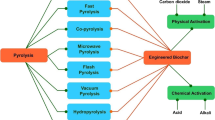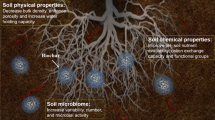Abstract
Electrochemical removal of sodium ion from fermented food composts was analyzed and statistically modeled by response surface methodology (RSM). Empirical models were developed to describe relationships between the operating variables (operation time, current density and water contents) and three responses (removal efficiency, energy expenditure and energy efficiency). Statistical analysis indicated that operation time and current density have significant effect on all responses. Good agreement between predicted and measured values confirmed the usefulness of the model. The models were verified by additional experimental at optimum conditions.
Similar content being viewed by others
References
Baek, K., Lee, H.-H., Shin, H.-J. and Yang, J.-W., “Electrochemical Removal of Sodium Ion from Fermented Food Composts,”Korean J. Chem. Eng.,17, 245(2000).
Baek, K., “Removal of Sodium in Food Wastes by Electrokinetics,” MSc thesis, KAIST, Korea (1999).
Box, G. E. P. and Draper, N. R., “Empirical Model-Building and Response Surfaces,” Wiley, New York (1987).
Carter, W. H. and Wampler, G. L., “Review of the Application of Response Surface Methodology in the Combination Therapy of Cancer,”Cancer Treat Rep.,70, 133 (1986).
Eaton, A. D., Clesceri, L. S. and CreenBerg, A. E., “Standard Methods for the Examination of Water and Wastewater,” 19th ed., American Publication Health Association, Maryland, USA, p.3-3~3-15 (1995).
Hagsten, I. and Perry, T.W., “Evaluation of Dietary Salt Levels for Swine. I. Effect on Gain, Water Consumption and Efficiency of Feed Conversion,”J. Animal Sci.,42, 1187 (1976).
Ismail, A., Soultani, S. and Ghoul, M., “Optimization of the Enzymatic Synthesis of Butyl Glucoside Using Response Surface Methodol-ogy,”Biotechnol Prog.,14, 874 (1998).
Kim, N.-C., “A Study on Recycling of Food Garbage-for Compost,”J. KOWREC,2, 51 (1994).
Lechno, S., Zamski, E. and Tel-Or, E., “Salt Stress-Induced Responses in Cucumber Plants,”J. Plant Physiol.,150, 206 (1997).
Lutts, S., Kinet, J.M. and Bouharmont, J., “Changes in Plant Response to NaCl During Development of Rice (Oryza sativa L.) Varieties Differing in Salinity Resistance,”J. Exp. Botany,46, 1846 (1995).
SAS/STAT Users Guide, Release 6.04 Ed. SAS Institute, Cary (1994).
Sen, R., “Response Surface Optimization of the Critical Media Components for the Production of Surfactin,”J. Chem. Tech. Biotechnol.,68, 263 (1997).
Shi, X.Q., Chang, K. C., Schwarz, J.G., Wiesenborn, D. P. and Shih, M. C., “Optimizing Pectin Extraction from Sunflower Heads by Alkaline Washing,”Bioresource Technology,58, 291 (1996).
Author information
Authors and Affiliations
Corresponding author
Rights and permissions
About this article
Cite this article
Baek, K., Shin, HJ., Lee, HH. et al. Statistical modeling of electrochemical removal of sodium in fermented food composts. Korean J. Chem. Eng. 19, 627–631 (2002). https://doi.org/10.1007/BF02699308
Received:
Accepted:
Issue Date:
DOI: https://doi.org/10.1007/BF02699308




